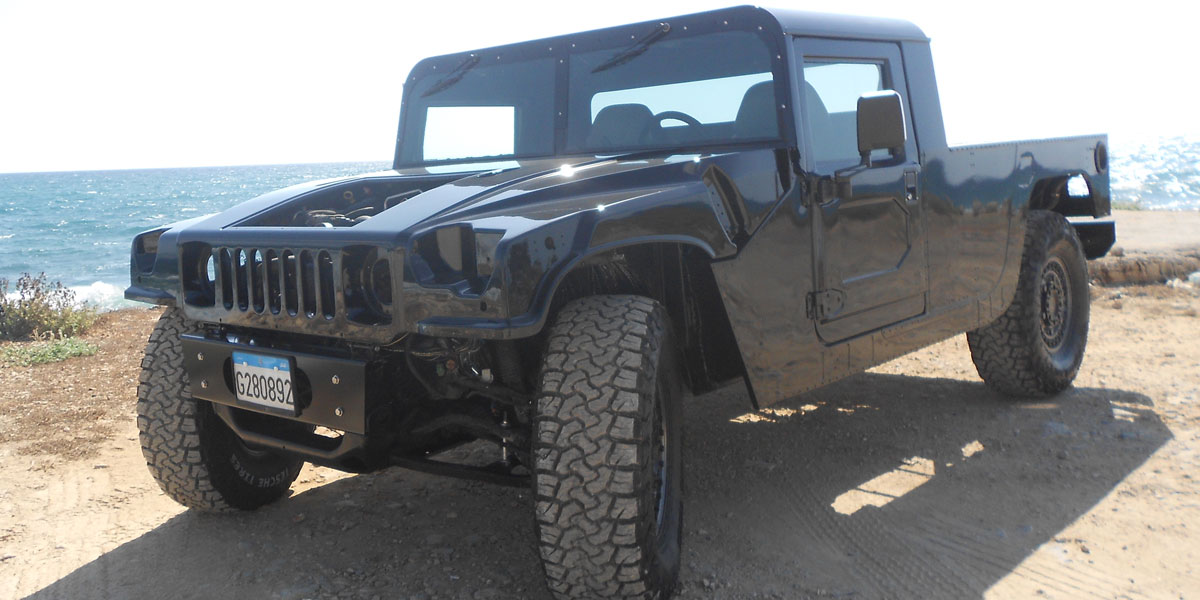Alumnus Refines Renowned High Mobility Vehicle
Car enthusiast and mechanical engineer Mansour Mansour builds his first automobile, addressing major shortcomings of the popular Hummer car.
Since he was 12, Mansour Mansour (BE ’14) has dreamt of owning a Humvee. Captivated by the rugged, military high-mobility vehicle that eventually became the civilian Hummer, he developed a passion for cars. This lifelong fascination naturally led him to major in mechanical engineering, paving the way for a flourishing career in the automotive industry.
Today, Mansour is the Workshop and Body Shop Manager at Scuderia Lebanon, The Official Ferrari Importer in Lebanon. Before this role, he held several key positions at automobile service centers in Lebanon and abroad, drawing on his extensive experience and dedication to the industry.
In this interview, Mansour discusses his prototype and how it overcomes the limitations of the original Humvee. He also fondly reflects on his memories of LAU and shares valuable advice for aspiring engineers.
What prompted you to build your own car? Can you tell us more about its functionalities, what challenges it addresses, and how it is different from the ones in the market?
I’ve always been passionate about cars and enjoyed building and modifying things. I was inspired to build my own after working for two years as a Ferrari workshop and body shop manager. I also happen to be a certified Ferrari master technician.
One of my latest projects was building a replica of a Humvee, a vehicle I had dreamt of owning since I was a kid, which I did for a while. But then, I recognized its limitations. Designed and built in the ’90s as an army vehicle, it was heavy, lacked creature comforts, and didn’t prioritize safety. This prompted me to create a modern version of my dream vehicle.
My car combines innovative technology with exceptional performance and aesthetics, addressing challenges such as fuel efficiency, sustainability and enhanced driving experience.
Unlike the original Humvee, it features modern amenities, a lightweight design for its category, and comprehensive safety features, making it comparable to any modern vehicle on the market.
Is the car market ready?
The car has been fully tested and is safe to drive, but the final steps involve ordering exterior parts and trim from the US. As a solo project with no financial support and all expenses covered out of pocket, this process will take several months.
What are your next steps regarding your invention?
I want to refine the design, conduct extensive testing to ensure optimal performance and exhibit it at various automotive expos and events to garner interest and feedback from industry experts and enthusiasts.
What were some of the other projects you worked on?
In 2012, as part of the university’s Kinematics and Dynamics of Linkages course, I designed an environmentally friendly vehicle powered by human propulsion. The following year, I created a computer-controlled robotic face that mimics facial expressions using LabView and mechanical linkages and gears.
For my final year project, I designed a four-passenger car-cycle with a mechanical storage system. This system engages while moving downhill to slow the car, reducing the need for conventional braking. The stored energy can then be used to propel the car forward.
What was your experience like back at LAU?
My time at LAU was transformative and laid the foundation for my career. The supportive environment and access to resources allowed me to explore my interests deeply. The diverse community and the emphasis on practical learning truly contributed to my personal and professional growth.
Can you describe a specific experience, course, or instructor at LAU that influenced your career choice and interest in car-building?
Several courses at LAU helped me define my career, including Dynamics, Strength of Material, Computer-Aided Design and my final-year project. Although we didn’t study anything specifically automotive-related, instructor Dr. Jimmy Issa was particularly influential. His passion for engineering and his encouragement motivated me to build projects. His mentorship played a crucial role in my decision to pursue a career in the automotive industry.
What are your future plans?
Looking ahead, I plan to continue innovating within the sector. My goal is to lead projects that focus on sustainable and efficient vehicle solutions. I would also like to mentor aspiring engineers and technicians and share my knowledge and experience to help shape the future of the industry.
Do you have any advice for current students and/or fresh graduates on how to succeed in today’s tough market?
I would encourage them to invest in their passions. Pursue what genuinely excites and motivates them, even if it seems challenging. Success often comes from dedicating yourself to what you love and continuously improving in that area. Stay curious, seek out opportunities to learn, and don’t be afraid to take risks. In today’s tough market, following your passion and staying committed to your goals can make a significant difference.
